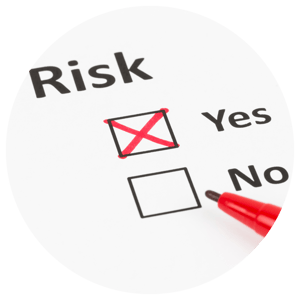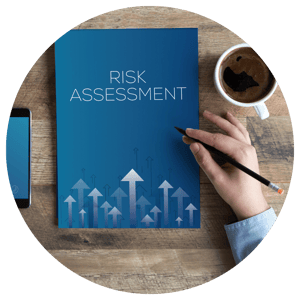Written By: MB Group
As a small business owner, it can feel at times as if hazards and risks are actively working against your success. While you may encounter similar risks as large Fortune 500 companies, the same hazard could result in a catastrophic outcome for your small business. Because of this, it's imperative you effectively engage in risk management.
Risk management is the process of properly identifying, managing, and mitigating risks. This strategic approach is engineered to help your business grow and thrive in any environment —in spite of known as well as unknown risks. Effectively managing risk can involve several protective actions and business insurances, but risk management should always start with a comprehensive risk assessment. As one would assume, risk assessment involves assessing risk. But there is much more to this strategic approach. Let's take a closer look at risk assessment and how the team at the MB Group can help.
 Risk
RiskIn terms of your small business, risk can be defined as anything that can impact your profitability. If the risk is severe enough, it could force your business to close. In general, there are two broad categories of risk:
Strategically leveraging risk management practices can help your business mitigate and confidently navigate risk. And risk management starts with and hinges on a thorough risk assessment. The risk assessment is designed to identify and spot potential risks and problems your business could face — whether it's risk associated with real estate investing or any other business venture.
However, the business-impact analysis goes further and examines how these risks and hazards could impact your business. Because the risk assessment and business impact analysis are closely tied together, it's often helpful to discuss them in conjunction with each other. The three key steps of conducting a risk assessment and business impact analysis are listed below:
The first step of the business risk assessment is to simply list out the unique risks your business may face. No matter your industry, the following hazards are likely to show up on your list.
 Step 2: What Assets Could Be Impacted
Step 2: What Assets Could Be ImpactedThis step is all about identifying the external or business assets that could be damaged or impacted by the risks you've listed in step one. Common examples could be:
The final step involves estimating the amount of damage or harm that could be done to your company. For instance, if your business is sued, you could face lawsuits, stiff penalties, and fines. On the other hand, if someone is injured at your business, you could also be fined for not being in compliance with regulations and rules. Another common example is if your business is the victim of a cyber-attack, you could lose customers and experience a damaged reputation.
When it comes to managing risk, it's imperative to be thorough and explore all possible scenarios. Then, you should examine the feasibility of the scenario as well as the cost-benefit analysis of mitigating the risk vs doing nothing. However, properly assessing risk can be timely and requires a specific level of expertise and experience. Fortunately, the team at the MB Group can help.
At the MB Group, we offer a comprehensive risk assessment service designed to help you effectively identify risks and create a plan to deal with these uncertainties. We will work closely with you to help you answer tough questions and turn your risk assessment into a real competitive advantage.
Contact us today for a risk assessment consultation.
Tags: Small Business
Investing in real estate, similar to any other endeavor, comes with a unique set of risks. And many of these risks are simply out of your control. For example, quickly changing demographics can be...
Read MoreManaging substantial wealth comes with unique challenges and opportunities, especially in today’s rapidly changing financial landscape. That's why high-net-worth individuals need sophisticated risk...
Read MoreIf you're a real estate investor or commercial property owner, one of the most valuable tax deductions is depreciation. While the concept of depreciation may not be foreign to most, it can become...
Read More